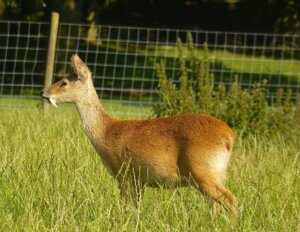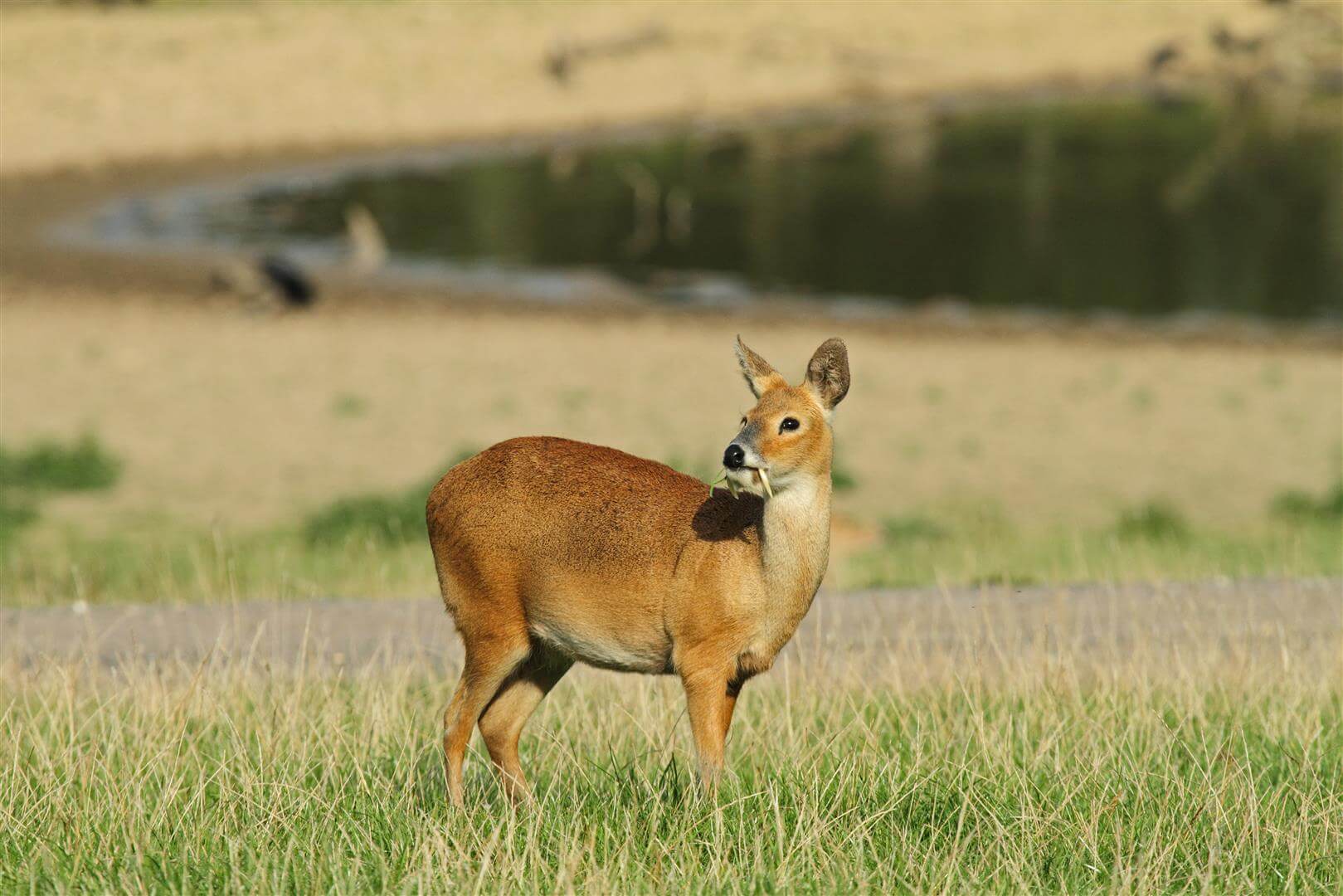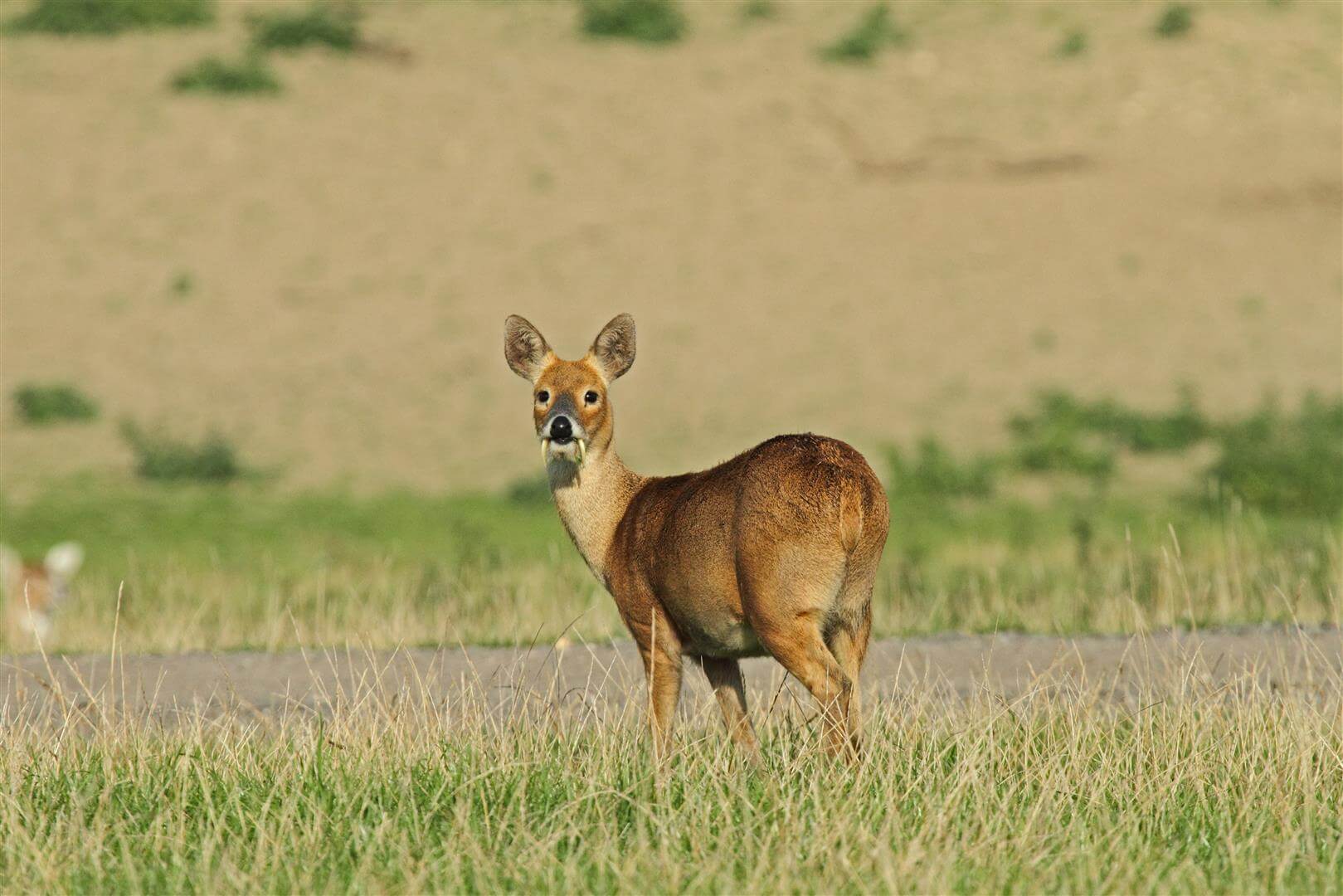The Water Deer: The Herbivorous Saber-Toothed Deer


Written and verified by the veterinarian and zootechnician Sebastian Ramirez Ocampo
The water deer is an exceptional ungulate mammal from the cervid family. So much so that it’s the only one in its genus (Hydropotes) and subfamily (Hydropotinae). Two important subspecies are distinguished, the Chinese water deer (Hydropotes inermis inermis) and the Korean water deer (Hydropotes inermis argyropus). Their main difference is their geographic location.
Unlike other species in the Cervidae family, such as the elk or reindeer, the water deer is the only one that doesn’t develop antlers as an adult. If you want to know the morphology, feeding habits, reproduction, and conservation status of this curious animal, then don’t miss the information we’re going to share with you in the following article.
Physical characteristics of the water deer
Water deer are relatively small animals. As adults, they can reach 50 centimeters (1.7 feet) in height and weigh 13 kilograms (28 lbs). Their robust body is protected by a coat of rough, hard hair, the golden coloration of which is uniform on the torso. Its face, on the other hand, is of a more grayish tone, while its limbs are whitish.
Like all cervids, it has long, strong limbs, a distinctive feature that allows them to flee quickly from any predator. As we stated earlier, and backed up by an article in the journal Scientific Reports, the water deer is the only species that doesn’t develop antlers, unlike its congeners.
Instead, nature has chosen to give them another, more surprising feature: two tusks that can grow to 8 centimeters (over 3 inches) in length.
Why tusks instead of horns?

According to a paper reported in Molecular Phylogenetics and Evolution, deer of the “ancient world” had both antlers and long tusks. However, by natural selection processes, the larger species retained their hooves instead of large teeth.
On the other hand, the smaller ones – such as the water deer – kept their long canines and lost the ability to develop antlers.
Although the processes involved in this phenomenon are unclear, a publication in the Journal of Mammalian Evolution has proposed a possible explanation.
According to the authors of this study, which related the size of the canines of 63 artiodactyl animals to their habitat and lifestyle, the more solitary and smaller species retained their fangs as a more effective defense mechanism compared to antlers.
In addition, they state that these species tend to live in environments with too much vegetation, so it could be difficult to move with large antlers through the dense forests of their ecosystems.
This statement is complemented by the arguments developed in a study in the Journal of Morphology. This research specifies that antlers in deer play a more social and reproductive role than a fighting role. That is to say, they function more as an appealing aspect of males for reproduction than as a defensive weapon.
What do the tusks of the water deer look like?
The “saber teeth” measure an average of 5 to 6 centimeters (around 2 inches) in males, but can be as long as 8 cm (over 3 inches). In females, they’re no longer than one centimeter in length (less than half an inch). This sexual dimorphism could be influenced by some factors such as parental care, because mothers are more in charge of caring for their offspring than of fighting and defending territories.
On the other hand, these teeth begin to emerge between 6 to 7 months of age, and finish developing at 2 years of age. Their inner structure is concave and their outer structure is convex, with a sharp, cutting, pointed edge.
According to a study published in the journal The Italian Journal of Mammalogy, the water deer has the ability to move its tusks. This action depends on the situation it finds itself in. For example, when grazing, it keeps them retracted so as not to hinder its feeding.
However, in aggressive encounters, it exposes its canines and moves them forward to appear more intimidating. In addition, thanks to this mobility, it avoids breaking its teeth when biting.
Where does it live?
The water deer is native to east-central China and the Korean peninsula. In China, it’s distributed along the Yangtze River valleys and on some islands such as Zhoushan, Jiangsu, and Hubei. In Korea, it is found all over the southern and northern territories.
According to a study published in the journal Animals, the population of Chinese water deer is seriously threatened. This is due to the destruction of natural habitats, climate change, and indiscriminate hunting by man, because in some parts of this Asian country it’s considered a “pest” due to its feeding habits.
In contrast, the Korean subspecies is enjoying a wide expansion and an increase in the number of individuals. In fact, its population growth in South Korea has led to socio-ecological problems, such as crop damage and collisions with vehicles.
Among other things, the water deer has a preference for environments with tall grass and thick vegetation, where it can find shelter and a place to hide. They can also be seen near swampy areas and on the banks of rivers, because they’re skilled swimmers.
This deer has also been introduced to countries such as the United Kingdom and France. However, in France, it was declared extinct. Even so, an expansion of the species has been observed in the eastern territories of Russia, on the border with China. This is reported in a study published in the journal PLOS ONE, published in the year 2022.
Feeding

The water deer is a herbivore that consumes a wide variety of woody plants, according to a study reported by the journal Scientific Reports. In addition, according to the authors, it has the ability to adapt to the climatic seasons and vary its diet according to the availability of vegetables.
Among its favorites are herbaceous plants, grasses, and some vegetables. Being a ruminant animal, it has four chambers in its stomach for the metabolism of plant material.
Reproduction of the water deer
This cervid species is a solitary animal, although during mating seasons it can be seen forming pairs for reproduction. However, according to an article in the journal Mammalia, the encounters are usually casual and there are few cases in which lasting relationships are sustained.
Females reach sexual maturity at 7 months of age, while males attain it at 6 months. Mating occurs between December and May, and gestation lasts 180 to 210 days. Generally, 2 to 5 offspring are born per litter and the mother is in charge of caring for them.
Males are usually very territorial. They actively mark the areas they inhabit, with strong odors left by their feces and urine. Likewise, the reproduction of this species is polygamous; that is, a male mates with several females found in its territory. In the wild, their life expectancy is approximately 12 years.
Conservation status
The International Union for Conservation of Nature (IUCN) has listed the water deer on its red list as a “vulnerable” species.
As described above, the main threats to the population of the Hydropotes inermis – especially in China – include the destruction of natural habitats, indiscriminate hunting, pollution of water sources, and climate change.
Although there are no exact figures for the number of this species currently found in China, it’s presumed to be less than the 30,000 reported in the 1990s. This is according to a recent study published this year in the journal Scientific Reports.
However, according to the authors of this article, the water deer has expanded into other territories, such as northeastern China, where years ago it had been exterminated.
Fighting extinction
Therefore, it could be thought that the measures taken for its conservation have borne fruit, although there’s still much work to be done. Some experts have suggested setting up breeding centers in order to reestablish their population on the Asian continent. In any case, all kinds of strategies will continue to be necessary to prevent the extinction of such a magnificent species.
The water deer is an exceptional ungulate mammal from the cervid family. So much so that it’s the only one in its genus (Hydropotes) and subfamily (Hydropotinae). Two important subspecies are distinguished, the Chinese water deer (Hydropotes inermis inermis) and the Korean water deer (Hydropotes inermis argyropus). Their main difference is their geographic location.
Unlike other species in the Cervidae family, such as the elk or reindeer, the water deer is the only one that doesn’t develop antlers as an adult. If you want to know the morphology, feeding habits, reproduction, and conservation status of this curious animal, then don’t miss the information we’re going to share with you in the following article.
Physical characteristics of the water deer
Water deer are relatively small animals. As adults, they can reach 50 centimeters (1.7 feet) in height and weigh 13 kilograms (28 lbs). Their robust body is protected by a coat of rough, hard hair, the golden coloration of which is uniform on the torso. Its face, on the other hand, is of a more grayish tone, while its limbs are whitish.
Like all cervids, it has long, strong limbs, a distinctive feature that allows them to flee quickly from any predator. As we stated earlier, and backed up by an article in the journal Scientific Reports, the water deer is the only species that doesn’t develop antlers, unlike its congeners.
Instead, nature has chosen to give them another, more surprising feature: two tusks that can grow to 8 centimeters (over 3 inches) in length.
Why tusks instead of horns?

According to a paper reported in Molecular Phylogenetics and Evolution, deer of the “ancient world” had both antlers and long tusks. However, by natural selection processes, the larger species retained their hooves instead of large teeth.
On the other hand, the smaller ones – such as the water deer – kept their long canines and lost the ability to develop antlers.
Although the processes involved in this phenomenon are unclear, a publication in the Journal of Mammalian Evolution has proposed a possible explanation.
According to the authors of this study, which related the size of the canines of 63 artiodactyl animals to their habitat and lifestyle, the more solitary and smaller species retained their fangs as a more effective defense mechanism compared to antlers.
In addition, they state that these species tend to live in environments with too much vegetation, so it could be difficult to move with large antlers through the dense forests of their ecosystems.
This statement is complemented by the arguments developed in a study in the Journal of Morphology. This research specifies that antlers in deer play a more social and reproductive role than a fighting role. That is to say, they function more as an appealing aspect of males for reproduction than as a defensive weapon.
What do the tusks of the water deer look like?
The “saber teeth” measure an average of 5 to 6 centimeters (around 2 inches) in males, but can be as long as 8 cm (over 3 inches). In females, they’re no longer than one centimeter in length (less than half an inch). This sexual dimorphism could be influenced by some factors such as parental care, because mothers are more in charge of caring for their offspring than of fighting and defending territories.
On the other hand, these teeth begin to emerge between 6 to 7 months of age, and finish developing at 2 years of age. Their inner structure is concave and their outer structure is convex, with a sharp, cutting, pointed edge.
According to a study published in the journal The Italian Journal of Mammalogy, the water deer has the ability to move its tusks. This action depends on the situation it finds itself in. For example, when grazing, it keeps them retracted so as not to hinder its feeding.
However, in aggressive encounters, it exposes its canines and moves them forward to appear more intimidating. In addition, thanks to this mobility, it avoids breaking its teeth when biting.
Where does it live?
The water deer is native to east-central China and the Korean peninsula. In China, it’s distributed along the Yangtze River valleys and on some islands such as Zhoushan, Jiangsu, and Hubei. In Korea, it is found all over the southern and northern territories.
According to a study published in the journal Animals, the population of Chinese water deer is seriously threatened. This is due to the destruction of natural habitats, climate change, and indiscriminate hunting by man, because in some parts of this Asian country it’s considered a “pest” due to its feeding habits.
In contrast, the Korean subspecies is enjoying a wide expansion and an increase in the number of individuals. In fact, its population growth in South Korea has led to socio-ecological problems, such as crop damage and collisions with vehicles.
Among other things, the water deer has a preference for environments with tall grass and thick vegetation, where it can find shelter and a place to hide. They can also be seen near swampy areas and on the banks of rivers, because they’re skilled swimmers.
This deer has also been introduced to countries such as the United Kingdom and France. However, in France, it was declared extinct. Even so, an expansion of the species has been observed in the eastern territories of Russia, on the border with China. This is reported in a study published in the journal PLOS ONE, published in the year 2022.
Feeding

The water deer is a herbivore that consumes a wide variety of woody plants, according to a study reported by the journal Scientific Reports. In addition, according to the authors, it has the ability to adapt to the climatic seasons and vary its diet according to the availability of vegetables.
Among its favorites are herbaceous plants, grasses, and some vegetables. Being a ruminant animal, it has four chambers in its stomach for the metabolism of plant material.
Reproduction of the water deer
This cervid species is a solitary animal, although during mating seasons it can be seen forming pairs for reproduction. However, according to an article in the journal Mammalia, the encounters are usually casual and there are few cases in which lasting relationships are sustained.
Females reach sexual maturity at 7 months of age, while males attain it at 6 months. Mating occurs between December and May, and gestation lasts 180 to 210 days. Generally, 2 to 5 offspring are born per litter and the mother is in charge of caring for them.
Males are usually very territorial. They actively mark the areas they inhabit, with strong odors left by their feces and urine. Likewise, the reproduction of this species is polygamous; that is, a male mates with several females found in its territory. In the wild, their life expectancy is approximately 12 years.
Conservation status
The International Union for Conservation of Nature (IUCN) has listed the water deer on its red list as a “vulnerable” species.
As described above, the main threats to the population of the Hydropotes inermis – especially in China – include the destruction of natural habitats, indiscriminate hunting, pollution of water sources, and climate change.
Although there are no exact figures for the number of this species currently found in China, it’s presumed to be less than the 30,000 reported in the 1990s. This is according to a recent study published this year in the journal Scientific Reports.
However, according to the authors of this article, the water deer has expanded into other territories, such as northeastern China, where years ago it had been exterminated.
Fighting extinction
Therefore, it could be thought that the measures taken for its conservation have borne fruit, although there’s still much work to be done. Some experts have suggested setting up breeding centers in order to reestablish their population on the Asian continent. In any case, all kinds of strategies will continue to be necessary to prevent the extinction of such a magnificent species.
All cited sources were thoroughly reviewed by our team to ensure their quality, reliability, currency, and validity. The bibliography of this article was considered reliable and of academic or scientific accuracy.
- Cabrera, D., & Stankowich, T. (2020). Stabbing Slinkers : Tusk Evolution Among Artiodactyls. Journal of Mammalian Evolution, 27, 265–272. https://link.springer.com/article/10.1007/s10914-018-9453-x
- Harris, R.B., & Duckworth, J.W. (2015). Hydropotes inermis. The IUCN Red List of Threatened Species 2015. Consultado el 2 de junio de 2023. https://www.iucnredlist.org/species/10329/22163569
- Heckeberg N. S. (2017). Origination of antlerogenesis. Journal of Morphology, 278(2), 182–202. https://onlinelibrary.wiley.com/doi/10.1002/jmor.20628
- Hu, J., Fang, S. G., & Wan, Q. H. (2006). Genetic diversity of Chinese water deer (Hydropotes inermis inermis): implications for conservation. Biochemical Genetics, 44(3-4), 161–172. https://link.springer.com/article/10.1007/s10528-006-9020-7
- Kim, Y. K., Koyabu, D., Lee, H., & Kimura, J. (2013). Sexual dimorphism of craniomandibular size in the Korean water deer, Hydropotes inermis argyropus. The Journal of Veterinary Medical Science, 75(9), 1153–1159. https://www.jstage.jst.go.jp/article/jvms/75/9/75_13-0125/_article
- Lee, S. K., Woo, C., Lee, E. J., & Yamamoto, N. (2022). Using high-throughput sequencing to investigate the dietary composition of the Korean water deer (Hydropotes inermis argyropus): a spatiotemporal comparison. Scientific Reports, 12(1), 22271. https://www.ncbi.nlm.nih.gov/pmc/articles/PMC9789119/
- Li, Y., Peng, Y., Li, H., Zhu, W., Darman, Y., Lee, D. K., Wang, T., Sedash, G., Pandey, P., Borzée, A., Lee, H., & Mo, Y. (2022). Prediction of range expansion and estimation of dispersal routes of water deer (Hydropotes inermis) in the transboundary region between China, the Russian Far East and the Korean Peninsula. PLOS ONE, 17(4), e0264660. https://www.ncbi.nlm.nih.gov/pmc/articles/PMC9009690/
- Li, Z., Khattak, R. H., Han, X., Zhang, N., Wu, J., Liu, Z., & Teng, L. (2023). Distribution update of water deer (Hydropotes inermis) and prediction of their potential distribution in Northeast China. Scientific Reports, 13(1), 5610. https://www.ncbi.nlm.nih.gov/pmc/articles/PMC10076520/
- Mauget, R., Mauget, C., Dubost, G., Charron, F., Courcoul, A., Rodier, A. (2007). Non-invasive assessment of reproductive status in Chinese water deer (Hydropotes inermis): Correlation with sexual behaviour. Mamm Biol 72, 14–26. https://link.springer.com/article/10.1016/j.mambio.2006.04.005
- Park, H. B., Woo, D., Choi, T. Y., & Hong, S. (2021). Assessment of the Behavioural Response of Korean Water Deer (Hydropotes inermis argyropus) to Different Fence Heights. Animals:an Open Access Journal from MDPI, 11(4), 938. https://www.ncbi.nlm.nih.gov/pmc/articles/PMC8067234/
- Pitra, C., Fickel, J., Meijaard, E., & Groves, P. C. (2004). Evolution and phylogeny of old world deer. Molecular Phylogenetics and Evolution, 33(3), 880–895. https://www.sciencedirect.com/science/article/abs/pii/S1055790304002374?via%3Dihub
- Samejima, Y., & Matsuoka, H. (2020). A new viewpoint on antlers reveals the evolutionary history of deer (Cervidae, Mammalia). Scientific Reports, 10, 8910. https://www.nature.com/articles/s41598-020-64555-7
- Schilling, A., & Rössner, G. E. (2017). The (sleeping) Beauty in the Beast – a review on the water deer, Hydropotes inermis. Hystrix, the Italian Journal of Mammalogy, 28(2), 121-133. http://www.italian-journal-of-mammalogy.it/The-sleeping-Beauty-in-the-Beast-a-review-on-the-water-deer-Hydropotes-inermis-,81678,0,2.html
- Sun, L., Dai, N. (1995). Male and female association and mating system in the Chinese water deer (Hydropotes inermis). Mammalia, 59 (2), 171-178. https://www.degruyter.com/document/doi/10.1515/mamm.1995.59.2.171/html
This text is provided for informational purposes only and does not replace consultation with a professional. If in doubt, consult your specialist.








